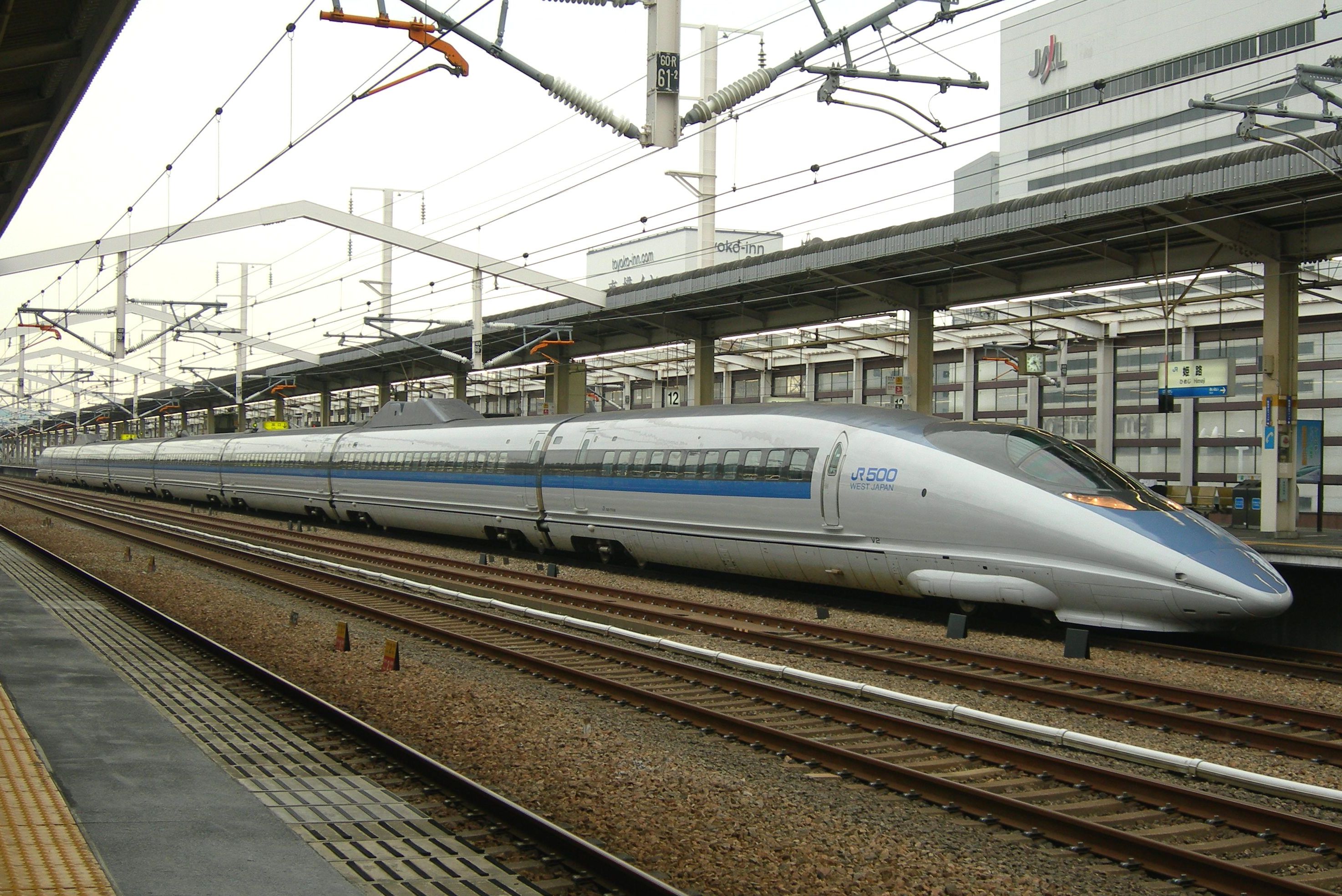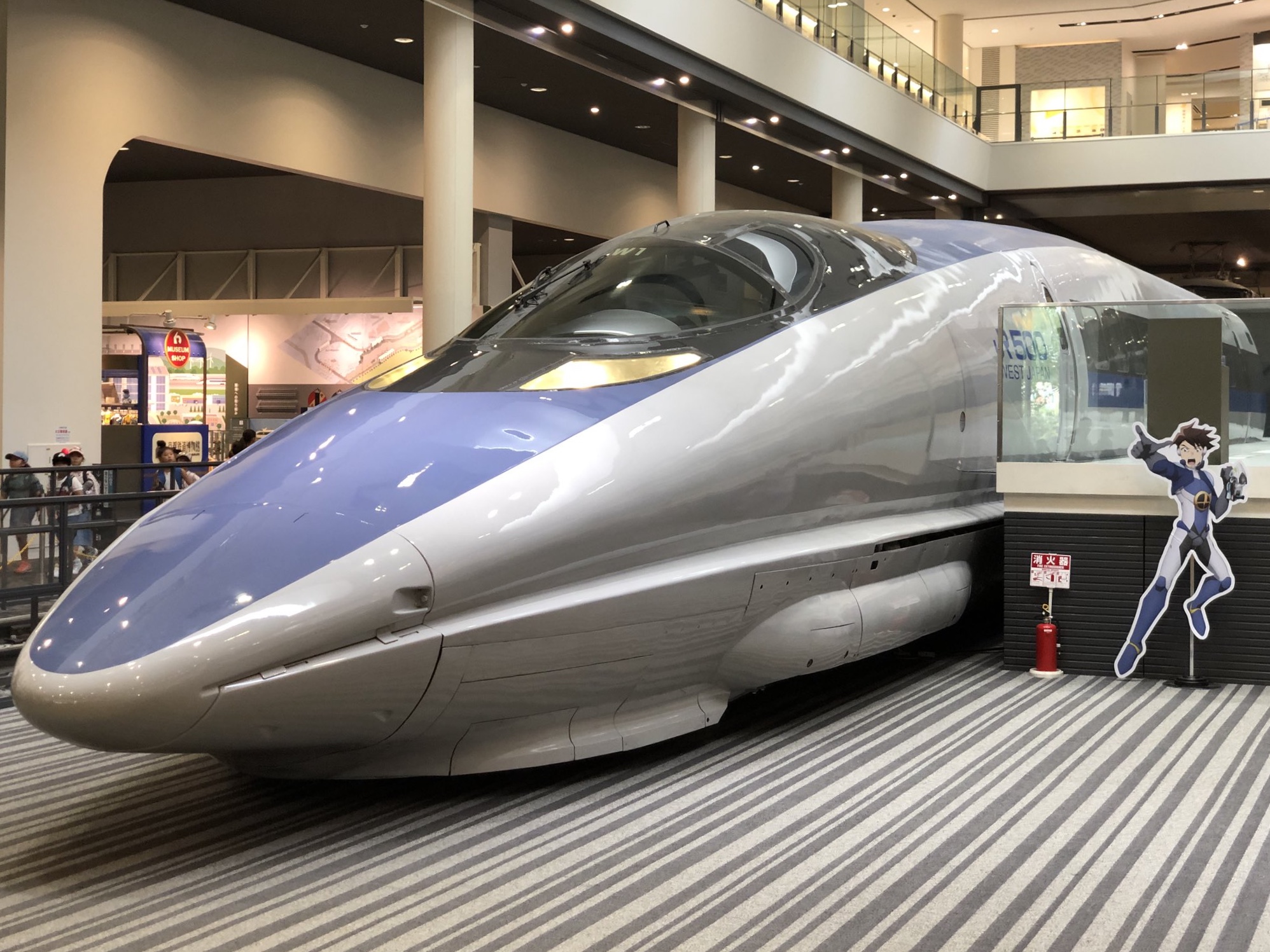500 Series Shinkansen on:
[Wikipedia]
[Google]
[Amazon]
The is a
File:500 Series Shinkansen inside.jpg, Standard-class car interior view
File:Blue Seat of JR 500.JPG, Standard-class seating
File:Green Car's Seat of JR 500.JPG, Green car seating
 Eight of the original nine 500 series sets were modified and shortened to eight cars between 2008 and 2010, and were cascaded to Sanyo Shinkansen '' Kodama'' workings, replacing the earlier 0 series sets. The first reformed eight-car set was unveiled to the press on 28 March 2008, and the trains entered service on twelve daily ''Kodama'' runs from 1 December 2008.
The maximum operating speed of these trains has been reduced to .
Eight of the original nine 500 series sets were modified and shortened to eight cars between 2008 and 2010, and were cascaded to Sanyo Shinkansen '' Kodama'' workings, replacing the earlier 0 series sets. The first reformed eight-car set was unveiled to the press on 28 March 2008, and the trains entered service on twelve daily ''Kodama'' runs from 1 December 2008.
The maximum operating speed of these trains has been reduced to .
File:JRW series500 ordinarycar-inside (Non-Reserved seat).JPG, Non-reserved seating car in May 2012
File:JRW series500 ordinarycar-inside (Reserved seat).JPG, Reserved seating car (car 6) in May 2012
File:JRW series500 smokingroom.JPG, Smoking compartment in car 7 in May 2012
File:JR West 500 giziuntendai2.jpg, Mock-up of the driver's cab in an 8-car 500 series trainset

 Since 7 November 2015, set V2 runs in a special "500 Type Eva" livery as part of the "Shinkansen:Evangelion Project" tie-up project to mark the 40th anniversary of the Sanyo Shinkansen and the 20th anniversary of ''
Since 7 November 2015, set V2 runs in a special "500 Type Eva" livery as part of the "Shinkansen:Evangelion Project" tie-up project to mark the 40th anniversary of the Sanyo Shinkansen and the 20th anniversary of ''
File:EVA521-7002.JPG, 521-7002 (Car 1)
File:EVA526-7002.JPG, 526-7004 (Car 2)
File:EVA527-7002.JPG, 527-7003 (Car 3)
File:EVA528-7002.JPG, 528-7002 (Car 4)
File:EVA525-7002.JPG, 525-7004 (Car 5)
File:EVA526-7202.JPG, 526-7202 (Car 6)
File:EVA527-7702.JPG, 527-7702 (Car 7)
File:EVA522-7002.JPG, 522-7002 (Car 8)
File:JRW-500 V2 20160320 TYPE EVA 526-7004 inside.jpg, The interior of car 2 in March 2016
File:JRW-500 V2 20160320 TYPE EVA 526-7004 waitingseat.jpg, Seats in car 2 designated for passengers waiting to use car 1
File:JRW-500 V2 20160320 TYPE EVA 521-7002 inside Evangelion cockpit.jpg, The Evangelion cockpit mockup in car 1

 Car 521-1, formerly the front car of set W1, is preserved at the
Car 521-1, formerly the front car of set W1, is preserved at the
JR-West 500 series ''Kodama''
{{JR-West rolling stock Shinkansen train series West Japan Railway Company Hitachi multiple units Train-related introductions in 1997 Passenger trains running at least at 300 km/h in commercial operations 25 kV AC multiple units Kawasaki multiple units Nippon Sharyo multiple units Kinki Sharyo multiple units Electric multiple units of Japan
Shinkansen
The , colloquially known in English as the bullet train, is a network of high-speed railway lines in Japan. Initially, it was built to connect distant Japanese regions with Tokyo, the capital, to aid economic growth and development. Beyond l ...
high-speed train
High-speed rail (HSR) is a type of rail system that runs significantly faster than traditional rail, using an integrated system of specialised rolling stock and dedicated tracks. While there is no single standard that applies worldwide, lines ...
type operated by West Japan Railway Company
, also referred to as , is one of the Japan Railways Group (JR Group) companies and operates in western Honshu. It has its headquarters in Kita-ku, Osaka. It is listed in the Tokyo Stock Exchange, is a constituent of the TOPIX Large70 index, and ...
(JR-West) on the Tōkaidō Shinkansen
The is a Japanese high-speed rail line that is part of the nationwide Shinkansen network. Along with the Sanyo Shinkansen, it forms a continuous high-speed railway through the Taiheiyō Belt, also known as the Tokaido corridor. Opened in 1964, ...
and San'yō Shinkansen
The is a line of the Japanese Shinkansen high-speed rail network, connecting Shin-Osaka in Osaka with Hakata Station in Fukuoka, the two largest cities in western Japan. Operated by the West Japan Railway Company (JR West), it is a westward cont ...
lines in Japan since 1997. They were designed to be capable of but operated at , until they were finally retired from the primary '' Nozomi'' service in 2010. The trainsets were then refurbished and downgraded to the all-stations '' Kodama'' service between and .
Overview
The general design concept was overseen by German industrial designer Alexander Neumeister. The running gear utilizes computer-controlledactive suspension An active suspension is a type of automotive suspension on a vehicle. It uses an onboard system to control the vertical movement of the vehicle's wheels relative to the chassis or vehicle body rather than the passive suspension provided by large sp ...
for a smoother, safer ride, and yaw dampers are fitted between cars for improved stability. All sixteen cars in each original trainset were powered, giving a maximum of . Each train cost an estimated 5 billion yen, and only nine were built. It used biomimicry
Biomimetics or biomimicry is the emulation of the models, systems, and elements of nature for the purpose of solving complex human problems. The terms "biomimetics" and "biomimicry" are derived from grc, βίος (''bios''), life, and μίμησ ...
to reduce energy consumption by 15%, increase speeds by 10% and reduce noise levels while increasing passenger comfort. This was done by making the train's front have the shape of a kingfisher
Kingfishers are a family, the Alcedinidae, of small to medium-sized, brightly colored birds in the order Coraciiformes. They have a cosmopolitan distribution, with most species found in the tropical regions of Africa, Asia, and Oceania, ...
's beak.
6-car 500-900 WIN350 set
This was a prototype for the Series 500.16-car W sets
First announced by JR-West in September 1994, the first set was delivered for testing in 1995, entering passenger service in March 1997. The entire fleet of nine sets was delivered by 1998. It was the first Shinkansen train in Japan to operate at a maximum speed of in regular passenger service. Besides the premium '' Nozomi'' services, 16-car trains were also used on '' Hikari Rail Star'' services during the busy holiday periods. With the steady increase in the number ofN700 Series Shinkansen
The is a Japanese Shinkansen high-speed train with tilting capability developed jointly by JR Central and JR West for use on the Tokaido and San'yō Shinkansen lines since 2007, and also operated by JR Kyushu on the Kyushu Shinkansen line.
...
since 2007, the 500 series were gradually retired from the ''Nozomi'' services. The last 500 series ''Nozomi'' run took place on 28 February 2010.
Formation
Cars 8 to 10 were "Green" (first class) cars. Cars 5 and 13 each had one "T"-style current collector.Interior
8-car V sets (500-7000 series)
 Eight of the original nine 500 series sets were modified and shortened to eight cars between 2008 and 2010, and were cascaded to Sanyo Shinkansen '' Kodama'' workings, replacing the earlier 0 series sets. The first reformed eight-car set was unveiled to the press on 28 March 2008, and the trains entered service on twelve daily ''Kodama'' runs from 1 December 2008.
The maximum operating speed of these trains has been reduced to .
Eight of the original nine 500 series sets were modified and shortened to eight cars between 2008 and 2010, and were cascaded to Sanyo Shinkansen '' Kodama'' workings, replacing the earlier 0 series sets. The first reformed eight-car set was unveiled to the press on 28 March 2008, and the trains entered service on twelve daily ''Kodama'' runs from 1 December 2008.
The maximum operating speed of these trains has been reduced to .
Formation
, the fleet consists of eight eight-car sets (V2 to V9) formed as follows, with car 1 at the Hakata end. Cars 2 and 7 each have one single-arm pantograph.Interior
Passenger accommodation consists of 3+2 abreast unidirectional seating, with 2+2 abreast seating in car 6 (former Green car). Between October and December 2013, cars 4 and 5 are also scheduled to have the original seating removed and replaced with new 2+2 abreast seating, the same as used in the ''Hikari Rail Star'' 700 series trainsets. All passenger saloons on the 8-car 500 series trains are no-smoking, with new smoking compartments installed in cars 3 and 7. Cars 1, 3, 5, and 7 are equipped with toilets.Special liveries

 Since 7 November 2015, set V2 runs in a special "500 Type Eva" livery as part of the "Shinkansen:Evangelion Project" tie-up project to mark the 40th anniversary of the Sanyo Shinkansen and the 20th anniversary of ''
Since 7 November 2015, set V2 runs in a special "500 Type Eva" livery as part of the "Shinkansen:Evangelion Project" tie-up project to mark the 40th anniversary of the Sanyo Shinkansen and the 20th anniversary of ''Neon Genesis Evangelion
, also known simply as ''Evangelion'' or ''Eva'', is a Japanese mecha anime television series produced by Gainax and animated by Tatsunoko, directed by Hideaki Anno and broadcast on TV Tokyo from October 1995 to March 1996. ''Evangelion' ...
''. Initially planned to operate until March 2017, this livery was extended until 13 May 2018. From 24 February until 7 May 2018, the 500 series car preserved at the Kyoto Railway Museum was exhibited in the "500 Type Eva" livery.
In March 2018, JR West announced the launch of a special "Hello Kitty
, also known by her full name , is a fictional Character (arts), character created by Yuko Shimizu, currently designed by Yuko Yamaguchi, and owned by the Japanese company Sanrio. Sanrio depicts Hello Kitty as an Anthropomorphism, anthropomorphi ...
" themed 500 series train on Sanyo Shinkansen Kodama services. The train entered service on 30 June 2018.
Interior
Preserved examples

 Car 521-1, formerly the front car of set W1, is preserved at the
Car 521-1, formerly the front car of set W1, is preserved at the Kyoto Railway Museum
The (formerly the until 2016) is a railway museum in Shimogyō-ku, Kyoto, Japan. The original Umekoji Steam Locomotive Museum opened in 1972, but was expanded and modernized in 2016, becoming the Kyoto Railway Museum.
The museum is owned by We ...
, which opened in April 2016. This car was exhibited in the "500 Type Eva" livery between 24 February and 7 May 2018.
Car 522-1, formerly the end car of set W1, is preserved at the Hitachi
() is a Japanese multinational corporation, multinational Conglomerate (company), conglomerate corporation headquartered in Chiyoda, Tokyo, Japan. It is the parent company of the Hitachi Group (''Hitachi Gurūpu'') and had formed part of the Ni ...
Kasado factory in Kudamatsu
is a city in Yamaguchi Prefecture, Japan. , the city has an estimated population of 55,119, with 24,392 households and a population density of 616 persons per km2. The total area is 89.44 km2.
The city was founded on November 3, 1939, being ...
, Yamaguchi, in Autumn 2015.
See also
*List of high speed trains
The following is a list of high-speed trains that have been, are, or will be in commercial service.
A high-speed train
High-speed rail (HSR) is a type of rail system that runs significantly faster than traditional rail, using an integrate ...
References
External links
JR-West 500 series ''Kodama''
{{JR-West rolling stock Shinkansen train series West Japan Railway Company Hitachi multiple units Train-related introductions in 1997 Passenger trains running at least at 300 km/h in commercial operations 25 kV AC multiple units Kawasaki multiple units Nippon Sharyo multiple units Kinki Sharyo multiple units Electric multiple units of Japan